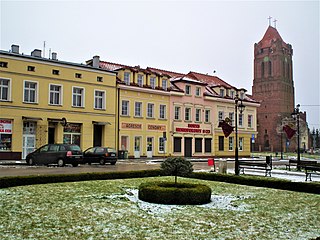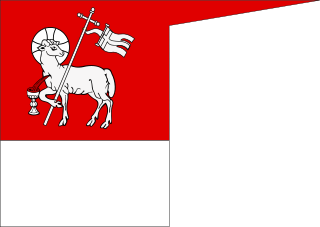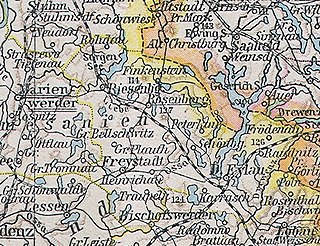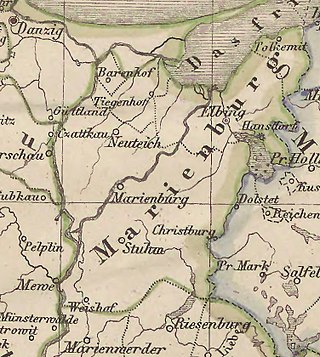
The district of Allenstein was a Prussian district in East Prussia, which existed from 1818 to 1945.

The district of Allenstein was a Prussian district in East Prussia, which existed from 1818 to 1945.
The area of the Allenstein district historically belonged to the Prince-Bishopric of Warmia, which fell to the Kingdom of Prussia with the First Partition of Poland in 1772. After the incorporation of Warmia into Prussia, the districts of Braunsberg and Heilsberg were set up in 1773, both of which were assigned to the Königsberg War and Domain Chamber. [1]
As part of the Prussian administrative reforms, a comprehensive district reform in all of East Prussia was necessary, as the districts established in 1752 and 1773 had proven to be inexpedient and too large. In Warmia, the new Allenstein district was formed from the southwestern part of the old Heilsberg district on February 1, 1818. The Allenstein district was assigned to Regierungsbezirk Königsberg, which emerged in 1808 from the old Königsberg War and Domain Chamber.
Since 1871, the district belonged to the German Empire. On November 1, 1905, the Allenstein district was assigned to the new Regierungsbezirk Allenstein. On April 1, 1910, the city of Allenstein left the district and formed its own urban district, known as Stadtkreis Allenstein. The remainder of the Allenstein district has since been referred to as Landkreis Allenstein.
In the 1920 East Prussian plebiscite, the Allenstein district belonged to the Allenstein voting area, the residents of which were to vote on whether they wished to join Poland or remain in Germany, in accordance with the provisions of the Treaty of Versailles. In the plebiscite, 86.53% of the votes were in favor of Germany and 13.47% were in favour of Poland, due to which it remained in Germany.
Towards the end of World War II in January 1945, the district was occupied by the Soviet Red Army and placed under Polish administration, in accordance with the Potsdam Agreement. The German residents of the district were expelled and only about 7% of the inhabitants, classified as "autochthonous Poles" were allowed to remain.
According to the Prussian census of 1861, the Allenstein district, which then also included the city of Allenstein, had a population of 47,901, of which 12,510 (26.1%) were Germans and 35,391 (73.9%) were Poles. [2]

Warmia is both a historical and an ethnographic region in northern Poland, forming part of historical Prussia. Its historic capitals were Frombork and Lidzbark Warmiński and the largest city is Olsztyn.

Olsztyn is a city on the Łyna River in northern Poland. It is the capital of the Warmian-Masurian Voivodeship, and is a city with county rights. The population of the city was estimated at 169,793 residents in 2021.

Prabuty is a town in Kwidzyn County within the Pomeranian Voivodeship of northern Poland. Before World War I, the town belonged to the German province of West Prussia. It was ceded to Poland in 1945. Between 1975 and 1998, Prabuty was part of the Elbląg Voivodeship.

East Prussia was a province of the Kingdom of Prussia from 1773 to 1829 and again from 1878 ; following World War I it formed part of the Weimar Republic's Free State of Prussia, until 1945. Its capital city was Königsberg. East Prussia was the main part of the region of Prussia along the southeastern Baltic Coast.

Royal Prussia or Polish Prussia was a province of the Crown of the Kingdom of Poland, which was established after the Second Peace of Thorn (1466) from territory in Pomerelia and western Prussia which had previously been part of the State of the Teutonic Order. Royal Prussia retained its autonomy, governing itself and maintaining its own laws, customs, rights and German language.

Prussia is a historical region in Europe on the south-eastern coast of the Baltic Sea, that ranges from the Vistula delta in the west to the end of the Curonian Spit in the east and extends inland as far as Masuria. This region is often also referred to as Old Prussia. Tacitus's Germania is the oldest known record of an eyewitness account on the territory and its inhabitants. Pliny the Elder had already confirmed that the Romans had navigated into the waters beyond the Cimbric peninsula (Jutland). Suiones, Sitones, Goths and other Germanic people had temporarily settled to the east and west of the Vistula River during the Migration Period, adjacent to the Aesti, who lived further to the east.

The Province of West Prussia was a province of Prussia from 1773 to 1829 and 1878 to 1920. West Prussia was established as a province of the Kingdom of Prussia in 1773, formed from Royal Prussia of the Polish–Lithuanian Commonwealth annexed in the First Partition of Poland. West Prussia was dissolved in 1829 and merged with East Prussia to form the Province of Prussia, but was re-established in 1878 when the merger was reversed and became part of the German Empire. From 1918, West Prussia was a province of the Free State of Prussia within Weimar Germany, losing most of its territory to the Second Polish Republic and the Free City of Danzig in the Treaty of Versailles. West Prussia was dissolved in 1920, and its remaining western territory was merged with Posen to form Posen-West Prussia, and its eastern territory merged with East Prussia as the Region of West Prussia district.

Wielbark is a town in Szczytno County, Warmian-Masurian Voivodeship, in northern Poland. It is the seat of the gmina called Gmina Wielbark. It lies approximately 19 kilometres (12 mi) south of Szczytno and 52 km (32 mi) south-east of the regional capital Olsztyn. It is part of historic Masuria.

Orzysz is a town in northeastern Poland, in the Pisz County, Warmian-Masurian Voivodeship, with 7,512 inhabitants (2007). It is located on Orzysz Lake in the region of Masuria.

Susz is a town in Iława County, Warmian-Masurian Voivodeship, Poland, with 5,600 inhabitants (2004).
Landkreis Marienwerder was a Kreis, or district, of Prussia from 1752 to 1945. Its capital was Marienwerder (Kwidzyn).
The West Prussia Region was a government region (Regierungsbezirk) of Prussia from 1920 until 1939. The regional capital was Marienwerder in West Prussia. It was the eastern part of Marienwerder Region which voted to be incorporated within the Weimar Republic and joined the Province of East Prussia from 1922 to 1939. It was replaced again by the reconstituted Marienwerder Region in 1939 until its dissolution in 1945.

Regierungsbezirk Allenstein was a Regierungsbezirk, or government region, of the Prussian province of East Prussia from 1905 until 1945. The regional capital was Allenstein. The territory today is part of the Polish Warmian-Masurian Voivodeship.

Regierungsbezirk Königsberg was a Regierungsbezirk, or government region, of the Prussian province of East Prussia from 1815 until 1945. The regional capital was Königsberg.

The East Prussian plebiscite, also known as the Allenstein and Marienwerder plebiscite or Warmia, Masuria and Powiśle plebiscite, was a plebiscite for the self-determination of the regions of southern Warmia (Ermland), Masuria and Powiśle, which had been in parts of the East Prussian Government Region of Allenstein and of the West Prussian Government Region of Marienwerder in accordance with Articles 94 to 97 of the Treaty of Versailles.

The Prince-Bishopric of Warmia was a semi-independent ecclesiastical state, ruled by the incumbent ordinary of the Warmia see and comprising one third of the then diocesan area. The Warmia see was a Prussian diocese under the jurisdiction of the Archbishopric of Riga that was a protectorate of the Monastic state of the Teutonic Knights (1243–1464) and a protectorate and part of the Kingdom of Poland—later part of the Polish–Lithuanian Commonwealth (1464–1772), confirmed by the Peace of Thorn in 1466. The other two thirds of the diocese were under the secular rule of the Teutonic Knights until 1525 and Ducal Prussia thereafter, both entities also being a protectorate and part of Poland from 1466.

The district of Rosenberg in Westpreußen was a Prussian district that existed from 1818 to 1945. The territory of the district is now located within the Polish Warmian-Masurian Voivodeship.

The Marienburg district was a Prussian district that existed from 1772 to 1945. The district originally belonged to the province of West Prussia and was divided in 1920 by the Treaty of Versailles. Its western half fell to the Free City of Danzig, while its eastern half became part of the province of East Prussia and remained in the German Reich until 1945. The district capital was Marienburg. The territory of the district is now part of the Pomeranian Voivodeship in Poland.

The Mohrungen district was a district in the southwestern part of the Prussian province of East Prussia. It existed from 1818 to 1945 and belonged to Regierungsbezirk Königsberg. The seat of the district administration was the town of Mohrungen. Prior to this, from 1752 to 1818 there was a Mohrungen district in East Prussia, which however, encompassed a much larger area.

The Rößel district was a Prussian district in the administrative region of Königsberg in the Prussian province of East Prussia. It was located in Warmia in the middle of East Prussia and existed from 1818 to 1945. The seat of the district administration was initially Rößel (Reszel) and, from 1862, Bischofsburg (Biskupiec).